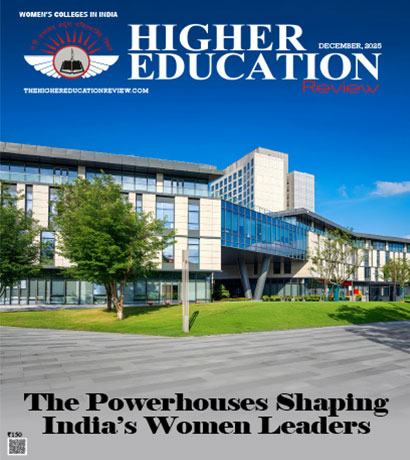Paving the Way for Digital Transformation in Higher Education
 Technology revolution in India has made it possible for students to follow their education in a low-cost and convenient manner. It can birth new ways of teaching as well as improve the existing ones. Institutions are responding smartly and rapidly to the implementation of the learning experience by adopting technological innovations. However, the problem with India is that its educational system is huge and complicated, comprised of more than 1000 universities and 45,000 colleges. The types of student’s interested in graduate studies are quite diverse. This means the needs of each type of student might be significant different. It is therefore a challenge to come up with a universally useful digital transformation strategy in higher education.
Technology revolution in India has made it possible for students to follow their education in a low-cost and convenient manner. It can birth new ways of teaching as well as improve the existing ones. Institutions are responding smartly and rapidly to the implementation of the learning experience by adopting technological innovations. However, the problem with India is that its educational system is huge and complicated, comprised of more than 1000 universities and 45,000 colleges. The types of student’s interested in graduate studies are quite diverse. This means the needs of each type of student might be significant different. It is therefore a challenge to come up with a universally useful digital transformation strategy in higher education.
The educational institutions, while they try to seize the advantages, face many challenges, which arise out of the digital transformation. These challenges include having the new technical skills that are required, implementing new processes, and the availability of the resources needed for successful implementation. Moreover, digital transformation may require changes to the existing systems and structures which can turn out to be cost-ineffective or due to inertia when it comes to organizational issues.
Technology Infrastructure for Digital Transformation
The digital divide in terms of access and equity still is a major issue that India needs to address urgently and requires the change in the current approach of the Department of Higher Education who should be markedly forward-looking and formulate a comprehensive strategy with immediate and decisive action to meet the growing demand for digital networks.
“The Covid pandemic has accelerated the process of digital transformation. Although technology or internet-based education has been around for over two decades, we did not use it as effectively as we do today. Not only are classes online, but exams and internships are also virtual. The blended model of education is here to stay. New technologies and applications in education play an important role,” said Anil D. Sahasrabudhe, Chairman, All India Council of Technical Education (AICTE).
There are several issues that are needed to be considered in the process of creating a strong digital foundation for higher education in India. Such issues are to do with the situation when people don’t have fast internet connections, lack investments in digital technology, as well as there aren’t any resources for training and education. It is crucial to the modernization of education that educational institutions have to provide the updated technology tools and system that will leads the transformation into digital world. This will enable them to continue meeting the current expectations of students and faculty members regarding their needs while also providing them with the possibility of getting better access to learning materials, resources, and tools via the internet.
Faculty Training to Leverage Digital Technology
It is imperative to map the curriculum and technology as there is a lack of knowledge on how to integrate technology to improve curriculum. The integration of educational technology is not a priority for many institutions. From the design of the curriculum to its execution, technology penetration is abysmally low. Classroom time is mostly spent on lecturing, with educators explaining topics and learners passively copying explanations from a blackboard. This setup leaves little time for practice in the classroom. As a result, learners who did not understand the material explained in class struggle when they have to solve assignments on their own. Technology can potentially solve this problem by allowing learners to review topics at their own pace.
Incorporating technology into the classroom has benefits which are widespread for both teachers and students. Integrating computer technology into the classroom can help teachers support and enhance learning, create opportunities to connect with students, and encourage students to engage with information in new and exciting ways. Through supportive instruction, clearly defined goals, and careful instruction on how to use technology effectively and responsibly, students will be equipped with new skills as digital learners that are linked to improved academic performance and increased personal and professional success.
Meeting Student Expectations
All for the sake of providing students with what they need, universities get into the difficult problem of meeting student expectations as they digitally transform higher education. The modern student expects more that they have at university life ever. These resources are in demand. Students want to experience personalized learning, as well as learning environments that are more engaging. To maintain this balance, the universities need to go through the digital transformation and deploy technology that can give rise to the interesting solutions that will make the educational offering better.
Universities can make learning more interesting and effective by the use of technologies e.g. artificial intelligence, machine learning, and virtual reality. Nonetheless, this process needs to be properly executed and planned in order to meet the needs of the students but still create a fruitful digital transformation experience for higher education institutions.
Digitally Transformed Education
Going further, digital transformation provides educational institutions high opportunities to deliver personalized programs that educate students. This will lower the costs, enhance efficiency, and improve their teaching and research activities. It is foreseen to transform the way universities are run in the future, making them become more efficient, quick-adapting, and cheaper while not sacrificing the quality of their services. Universities can exploit technology (such as AI, machine learning and analytics) to give users personalized learning experiences that are customized to the needs of each individual. Moreover, digital transformation will allow universities to scale up their production fast and efficiently keeping the traditional teaching and research standards very high.

